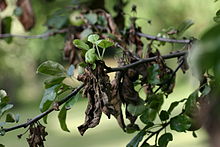Fire blight
Fire blight is a contagious disease of rosaceous plants [1] The pathogen is Erwinia amylovora, a Gram-negative bacterium in the family Enterobacteriaceae. If the conditions are right, it can destroy an entire orchard in a single growing season.


Infections get into open blossoms and tender new shoots and leaves in the spring when blossoms are open. There is no known cure; prevention is the key.[2] Spraying plants with streptomycin or injecting plants with oxytetracycline can prevent new infections. That leads to antibiotic resistance. Spraying beneficial bacteria or yeast may also prevent fire blight from infecting new trees. The only effective treatment for plants already infected is to cut off the affected branches and dispose of them.[3]

References
change- ↑ Cabrefija I Olamendi J. 2004. Fire blight (Erwinia amylovora) of rosaceous plants Patogen virulence and selection and characterization of biological control agents Archived 2016-03-07 at the Wayback Machine
- ↑ "Fire Blight". Colorado State University. Archived from the original on October 21, 2014. Retrieved November 13, 2014.
- ↑ Burn them or take them out of the area.